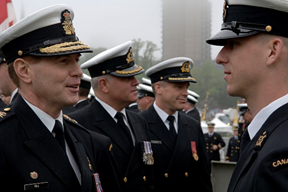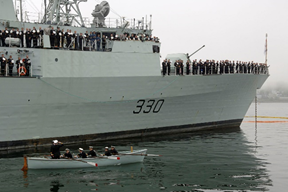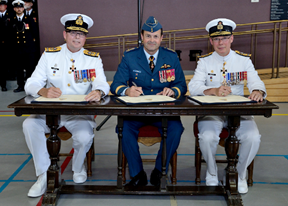Change of Command – The Ceremony
This information was prepared by the Royal Canadian Navy Headquarters, History and Heritage Section, and is published with permission.
Bestowing power and authority to certain delegated individuals is a necessary part of any complex society. It enables the coordinated and sometimes autonomous execution of those duties and responsibilities for which they have been tasked for the greater good. It is equally necessary that those individuals return those powers and authorities once those duties and responsibilities have been completed or they are handed over to another individual. Throughout history we have witnessed those that are reluctant to relinquish those powers and have seen the tremendous harm that can arise. The Royal Canadian Navy (RCN), as part of the professional development of our sailors and officers, delegates to them over the course of their career increasingly greater positions of power and authority. The RCN also instills in our sailors and officers, through routine and ceremony, that those powers and authorities must in turn be transferred to another. The smooth transition of power and authority from one to another is a vital pillar of a fair and lawful society—and of any military organization.

The Change of Command ceremony is a critical cornerstone of the Canadian Armed Forces and the RCN. For those charged with the defence of our country, they will be entrusted with power and authority that few Canadians will ever experience. If we may borrow from Stan Lee’s Spider-Man, the Peter Parker Principle states that with great power comes great responsibility.

Our adherence and observance of ceremony, customs, and traditions reaffirms and strengthens within us an appreciation of the trust the people of Canada have granted us for over 110 years. The Change of Command ceremony displays for all the transparent transition of power and authority, identifying who has been delegated the power and to whom they are responsible.

This transition of power and authority requires a great deal of effort. The various departments on the ship prepare briefings to the incoming commanding officer on all aspects of the ship’s status. At a formation or national headquarters, Directors and Directors General subordinate to the incoming Commander will advise him/her on the status of the formation or national command. Once the briefings are completed and the incoming commanding officer is satisfied, the official Change of Command ceremony takes place. For a ship, from which all other naval Changes of Command take their cue, the ceremony usually involves the inspection of the ship’s company by the incoming commanding officer, a farewell address from the departing commanding officer, and the formal signing of a certificate identifying the outgoing and incoming commanding officers. The transfer is overseen by the senior officer to whom the incoming commanding officer will be responsible.

In the case of the Commander of the RCN, who reports to the Chief of the Defence Staff (CDS), the CDS will officiate at the Change of Command. After the signing the incoming commanding officer gets an opportunity to address his/her ship’s company (crew) for the first time. At the conclusion of the speeches the ship’s company will salute the outgoing commanding officer one final time and march past. On a ship the outgoing commanding officer is usually rowed ashore in a boat by his/her senior officers while the crew lines the ship’s guardrails and cheers for them.
A PDF of this Note is available here.




